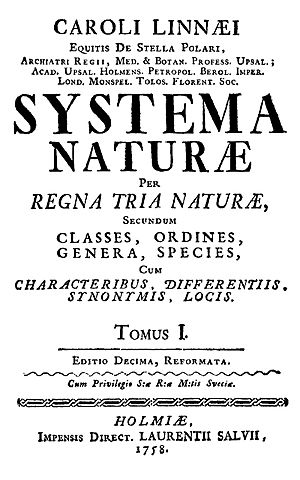Systema Naturae facts for kids
Systema Naturae (sometimes written Systema Naturæ) is a very important book written by a famous scientist named Carolus Linnaeus. In this book, he made a huge list and organized all the plants, animals, and even minerals that people knew about at the time. The first edition of the book was quite small, made up of only seven large sheets of paper.
Contents
What is Systema Naturae?
Systema Naturae means "System of Nature" in Latin. It's the main work of Carolus Linnaeus, a Swedish scientist. He is often called the "father of modern taxonomy". Taxonomy is the science of naming, describing, and classifying living things.
How Linnaeus Organized Life
Before Linnaeus, it was hard to keep track of all the different plants and animals. People used very long and confusing names. Linnaeus created a simple, clear system to name and group living things. This system is still used today!
Naming Species: Two Names for Every Living Thing
Linnaeus introduced a way of naming species called "binomial nomenclature". This means every species gets a two-part name.
- The first part is the genus name. It's like a family name.
- The second part is the species name. It's like a unique first name.
For example, humans are named Homo sapiens. Homo is our genus, and sapiens is our species. This system made it much easier for scientists all over the world to talk about the same plant or animal.
Grouping Living Things: A Hierarchy
Linnaeus didn't just give things names. He also put them into groups, from biggest to smallest. Imagine a set of Russian nesting dolls, where each doll fits inside a bigger one.
- He started with big groups like kingdoms (animals, plants, minerals).
- Then he broke those down into smaller groups like classes, orders, genera (plural of genus), and finally species.
This way of organizing things helps us understand how different living things are related to each other.
Who Was Carl Linnaeus?
Carolus Linnaeus was born in Sweden in 1707. He loved nature from a very young age. He studied medicine and botany (the study of plants) at university. His passion was to explore and understand the natural world.
Linnaeus's Travels and Discoveries
Linnaeus traveled a lot, especially in Sweden. He collected many plants and animals. He carefully observed them and wrote down their features. These observations helped him create his famous classification system. He wanted to make sense of the huge variety of life on Earth.
The Impact of Systema Naturae
The first edition of Systema Naturae was published in 1735. It was a small book, but it changed science forever. Linnaeus kept updating and expanding it throughout his life. The 10th edition, published in 1758, is especially important. It's often seen as the starting point for modern biological naming. Thanks to Linnaeus, scientists now have a common language to describe and understand the natural world.
Images for kids
See also
 In Spanish: Systema naturæ para niños
In Spanish: Systema naturæ para niños



